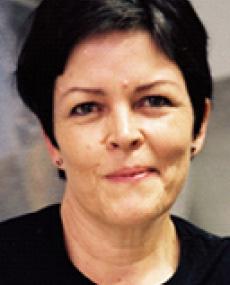
This biography was written by SAHO in collaboration with Artthrob
MODUS OPERANDI
Jo Ractliffe is a documentary photographer who captures the traces of violence, displacement and struggle in a landscape. The images evoke memory and history and the untold stories of the aftermath of conflict. Her work engages with the remnants and vestiges visible as scars in the landscape.
Ractliffe uses a wide range of photographic and art practices, including snapshot, documentary, forensic and studio photography, as well as installation video and projections. However her main chosen medium is the analog black and white image which captures a reality bordering on the mysterious which the artist emphasizes in her printing techniques.
BIOGRAPHY
Ractliffe was born in 1961 in Cape Town and she completed her BAFA and MFA degrees at the University of Cape Town.
Photographic and art education has been a priority for Ractliffe and she has lectured as well as conducted workshops at private and public institutions throughout South Africa and abroad including the Salzburg Summer Academy in Austria. She has been known to collaborate with many other artists on building educational platforms including Rory Bester on PhotoFocus. She explores photography education across disciplines, histories, spaces and experiences. She is also a teacher at the Market Photo Workshop and serves on the advisory board.
Ractliffe was one of the founding members and curator of the Joubert Park Project, a socially directed public art initiative located in the inner city of Johannesburg (2000/01). This was followed by Johannesburg Circa Now, a collaboration with fellow artist, Terry Kurgan, at the Johannesburg Art Gallery in July 2004.
In 2015 Ractliffe’s was one of the selected few to have a solo exhibition at the Metropolitan Museum in New York, The Aftermath of Conflict: Jo Ractliffe's photographs of Angola and South Africa, which featured the series Terreno Ocupado (2007).
Other solo exhibitions of note are: Walther Collection Project Space, New York (2011); Fotohof, Salzburg (2012); and Museet for Fotokunst, Odense (2013); and The Borderlands (2013). After War at Foundation A Stichting, Brussels (2015), and Someone Else's Country at the Peabody Essex Museum, Salem, Massachusetts, (2014).
Group exhibitions include; After Eden / Après Eden - The Walther Collection at La Maison Rouge, Paris (2015); Conflict, Time, Photography at the Tate Modern, London (2015); Public Intimacy: Art and Other Ordinary Acts in South Africa at the Yerba Buena Center for the Arts, San Francisco (2014); Apartheid and After at Huis Marseille, Amsterdam (2014); Distance and Desire: Encounters with the African Archive, Walther Collection, Ulm (2013); Making History at Museum Moderne Kunst, Frankfurt (2012); Rise and Fall of Apartheid: Photography and the Bureaucracy of Everyday Life at the International Centre of Photography, New York (2012); New Topography of War at Le Bal, Paris (2011); Figures and Fictions: Contemporary South African Photography at the V&A Museum, London (2011); Events of the Self: Portraiture and Social Identity, The Walther Collection in Neu-Ulm/Burlafingen, Southern Germany (2010); the 7th Gwangju Biennale, Korea (2008); Snap Judgments: New Positions in Contemporary African Photography, International Centre for Photography, New York, and other venues (2006-8), and The Unhomely: Phantom Scenes in Global Society, 2nd International Biennial of Contemporary Art (Biacs 2), Seville (2006).
In 2010 she was awarded a Writing Fellowship at the Wits Institute for Social and Economic Research (WISER). In 2011 she was nominated for the Discovery Prize at the Rencontres d'Arles photography festival, and As Terras do Fim do Mundo was nominated as best photobook of 2010 at the International Photobook Festival in Kassel (2011).
SOURCES
Three of Ractliffe’s major series of work focus on the Angolan Civil War and the relationship with South Africa. The first series titled Terreno Ocupado (2007–8), was made while Ractliffe's first visited Angola's capital, Luanda. The images captured were made five years after the end of the Civil War. The black and white photographs emphasize the structural fragility of the capital’s poorer areas as well as the marks on a place which has been fought over, occupied and even left.
The Angolan Civil War which lasted twenty seven years (1975 – 2002) and the independence movement was spear-headed by three vastly different organisations that turned on each other after Portugal exited the country. Differing political and economic ideologies as well as being resource rich meant ensured that each of which had a Cold War patron.
For the series As Terras do Fim do Mundo (2009–10), Ractliffe spent time with ex-soldiers while they traveled to the desolate places they had fought in the Angolan countryside. The images reflect the desolation, hiding and subtle re-growth into the mass areas of space.
South Africa played a major role in the Angolan Civil War and from 1978 to 1984 South African soldiers fought against the Angolans. The warfare between People’s Liberation Army of Namibia (PLAN) also escalated into a full blown war between South Africa and Angola, which took place in 1981. An estimated 10 000 guerrillas lost their lives and South West Africa People’s Organization (SWAPO) was reduced to carrying out terrorist attacks. In Ractliffe’s series The Borderlands (2011–13) she examines the impact of the wars in Angola inside of South Africa's borders, as well as photographing the landscapes militarized and had been taken over by the South African army.
CURRENTLY
Jo Ractliffe and Penny Siopis are both participating artists in the Taipei Biennial 2016, 10 September 2016 - 5 February 2017. The theme of the biennial, curated by Corinne Diserens, is 'Gestures and archives of the present, genealogies of the future: A new lexicon for the biennial'. Ractliffe is a senior professor at Wits School of Arts and currently a Research Fellow at the Centre for Curating the Archive at the University of Cape Town.